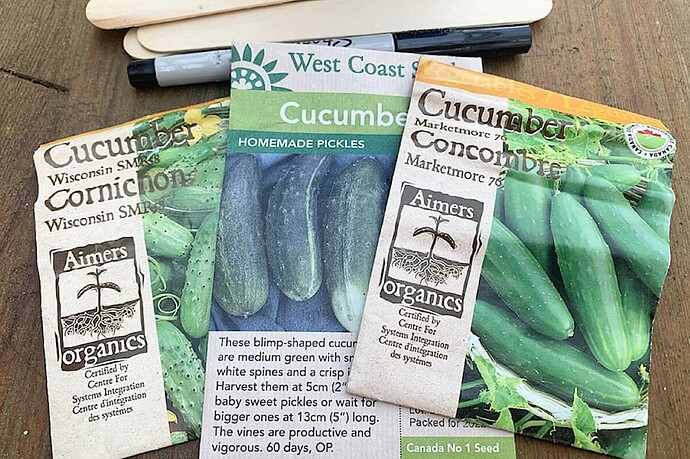Article and photograph by Marion Waters, Master Gardener. Republished courtesy of the Campbell River Mirror.
Crisp, mildly sweet, and refreshingly watery, cucumbers picked at peak ripeness are a delight on a hot day. For a few dollars spent on seeds or starter plants, you can reap high yields that will rival the infamous zucchini.
Cucumbers (Cucumis sativus) are a warm-weather crop. Like tomatoes, peppers, and squashes, they grow best when soil temperatures are above 15 C. Wait for those balmy days in June before planting out your starter plants or seedlings. If necessary, transfer to larger pots as you wait for conditions to be right.
But let’s begin at the beginning. Cucumbers are easy to grow from seeds. If May and June are particularly warm, you can even direct-sow them. Prepare your site by amending with compost or composted manure. Place a cut-off milk jug over each seedling to trap in warmth and moisture until the plants have outgrown the space. However, a few seeds sown outdoors always go missing, either due to birds or rodents or your own pets and kids! Sowing the seeds into pots and placing them in a protected area may be more cost-effective. A greenhouse, cold frame, sunny south-facing window, or protected porch can all work. Use a heat pad underneath the seed tray to speed up germination. (Heat pads are costly but well worth the investment if you enjoy growing your own plants from seed and you don’t have a heated greenhouse.) You may wish to do a second sowing two-to-three weeks after the first sowing. This second batch of plants will produce well into September when your initial plants may be dying off.
Choose varieties according to your needs and growing situation. If you like to make pickles, then grow pickling cucumbers. They can also be eaten fresh but have firmer skins and are smaller than slicer varieties. Grow some seedless slicing cucumbers as well. Choose the “burpless” variety for obvious reasons but also because they tend to be less bitter. If pickles are bitter, it may be because the plant is stressed due to excessive heat and/or inadequate water. Cut off about 2 cm next to the stem and peel more deeply than you normally would and they can still be eaten. You may wish to grow a quirky variety just for fun such as heirloom lemon cucumbers or curled Asian long cucumbers.
Seeds take about three to four weeks to grow robust enough to plant out (watch for that third serrated leaf to show), and fifty to seventy days of warm weather to reach harvest. Don’t forget to harden them off; leave seedlings out in the open for an increasing number of hours over a period of a few days to a week. This acclimatizes them to cooler temperatures, wind, and direct sunlight. Cucumber vines can be left to meander over a huge space like squashes. However, you will probably get better results if you train them to grow upwards onto a fence or trellis. Keeping the vines and fruit off the ground keeps them away from dampness and may help prevent leaf rust and rotting fruit. They also get better sun exposure and can be planted closer together, about 30 cm (1 foot) apart. Bush varieties are ideal for pots but can also be grown in the garden if there are limited options for vertical growth.
Cucumbers are shallow-rooted plants and therefore need frequent watering. Avoid getting water on the leaves. Mulch well to hold warmth and moisture in and to shade the roots during hotter days. Cucumber plants do not like to be too wet or too dry. Long hot spells with inadequate watering can shut the plant down and lead to a disappointing crop. They are also heavy feeders and will need regular top-ups of compost or composted manure.
Stems produce tendrils, leaves, blossoms, and new branches all from the same junction. Pinch out some of the new branches to prevent too much spreading, particularly down low to the ground. This also allows more of the plant’s energy to be used in fruit production. Pinch out tips of leading stems once they have reached the top of your supports.
Harvest cucumbers regularly before they get too big (not more than 5 cm or 2 inches in diameter). Fruits left to turn yellow will set seeds and the plant may shut down its production. The more you harvest, the more the plant will continue to produce. Refreshing, low in calories and offering many health benefits, cucumbers can be added to salads, smoothies, dips, pickles, drinks, and soups.
Photo caption: For a few dollars spent on seeds or starter plants, cucumbers can reap high yields that will rival the infamous zucchini.
